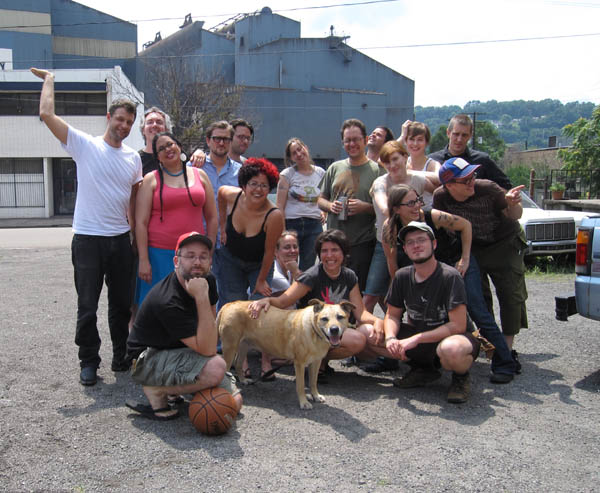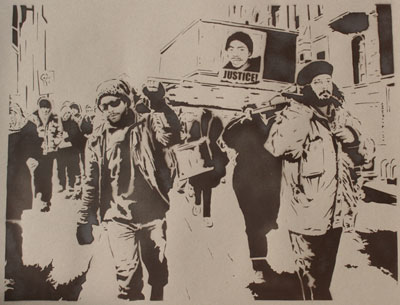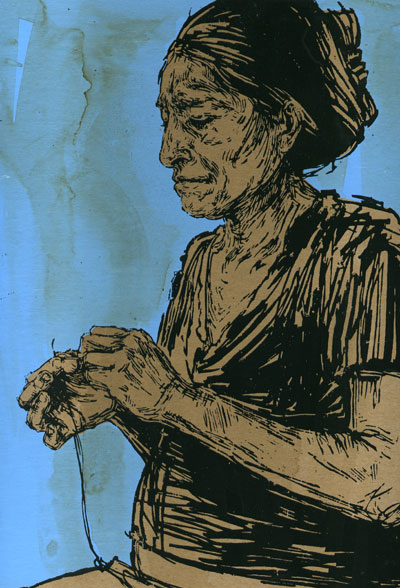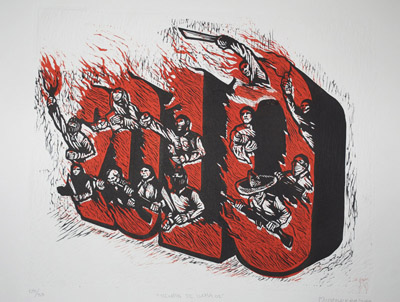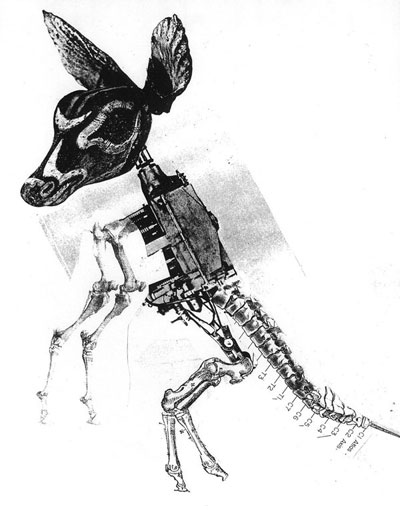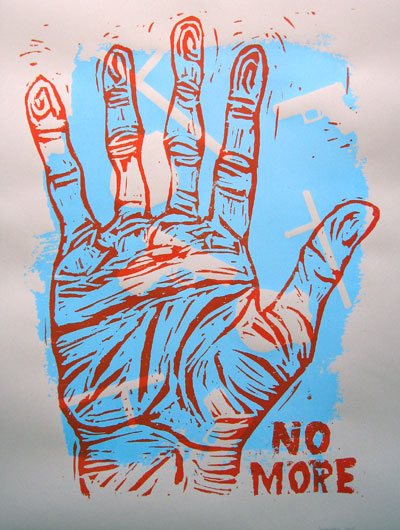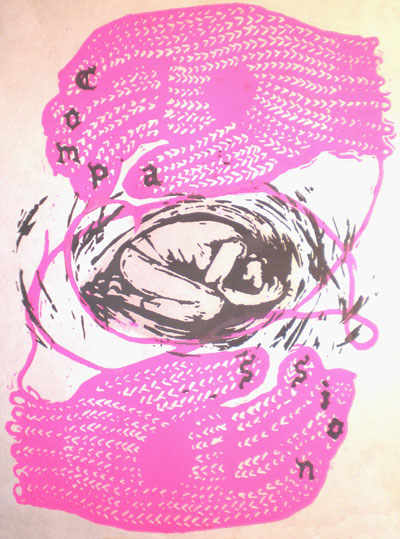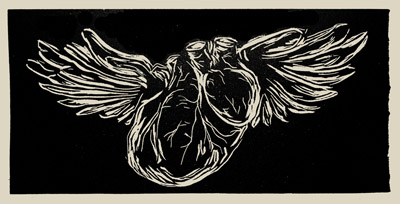Justseeds are one of the leading and most prolific artist-run radical art collectives at work today and count an amazing array of artists such as Swoon, Chris Stain, Kevin Caplicki, Meredith Stern and Josh Macphee among their members. AM recently caught up with many of the members of Justseeds and asked them a stack of questions about life creating and distributing a huge amount socially aware art and running one of the finest art resistance blogs in the world. Take some time out to check out their answers and more info about their work after the jump.
Back in 1937, politically engaged Mexican artists (Leopoldo Mendez, Pablo O’Higgins and Luis Arenal) formed the Taller de Grafica Popular (translated as the Workshop for Popular Graphic Art) to realize the potential that printmaking offered to support and express the aims and ideals of the Mexican Revolution. Not only was printmaking quick and cheap, but the images also allowed the artists to communicate ideas in a way that many of the largely uneducated population would be able to quickly and easily understand. By 1949 over 26 active members were participating in the Taller de Grafica Popular creating artwork that not only looked great but also expressed the social realities of life in Mexico such as freedom of the press, worker’s rights, and land reform. The Taller’s output was legendary and gained massive support for the principles of the revolution as well as producing some incredibly powerful graphic artwork.
Since that time artist-run radical art collectives addressing themes of social justice have appeared around the world. Following this important tradition is Justseeds which began back in 1998 when artist Josh MacPhee needed a way to distribute his own art and a poster series called “Celebrate People’s History” which centered on those who fought for social justice and freedom but were rarely acknowledged by the wider world. Slowly the organization grew and in 2006, Justseeds was reborn as a fully-fledged decentralized artist/worker owned and run co-operative which now numbers some 26 members. Today, Justseeds is the place to go if you want to get an update on creative social movements, learn about artistic protest or pick up a piece of amazing and affordable artwork with a message from an enormous range of familiar and unfamiliar artists including hand finished Swoon linocuts, Chris Stain stencil work, Meredith Stern’s artist books and much, much more. Justseeds have also just put a shout out for support for their 2010 Justseeds Portfolio: Resourced – to find out how you can help and get involved with this project check out this link.
AM recently had the chance to catch up with some of the members of Justseeds and here’s what they had to say:
Arrested Motion (AM): Can you tell us how you became involved in Justseeds and what’s your role within the organization?
Dylan: Sadly I am one of the premiere slackers in the collective. As a worker-run cooperative, we physically get together once a year, with quarterly conference calls and an ongoing intranet site. This allows us to maintain communication with over 25 members in at least three countries. Each individual takes on a certain functional responsibility, as well as at least one annual project. This is still being worked out as certain members, folks in NYC, Portland, Pittsburgh and Milwaukee have engaged in more collective labor than slackers like myself.
Roger: I’ve been gradually accruing more responsibility within the Justseeds structure; currently I’m the principal order-filler, copy-editor, item-scheduler, and accountant. I’m the basement troll tinkering with the brain and organs of the beast.
Bec: I became really interested in learning about how people can work together in a healthy, non-hierarchical way after running a community bike shop collectively for many years. So for the first couple years, out of this interest, I organized and facilitated much of the annual meetings. This past year, I have been working on a book, which is our first collectively created book.
Pete: I offered to house the entire distro of Justseeds in my basement when Clamor magazine collapsed and Justseeds had no home. I built all the shelves, answer the phone, pack orders, get the mail, answer and ignore questions.
Kevin: I have always had a disobedient disposition – from catholic school to police officers, I have constantly questioned authority. I’ve always been too critical to follow orders and was always drawn to the independence of skateboarding and graffiti. I used to pull all sort of pranks and paint things, which later became defined as “culture-jamming”, when I discovered publications like Adbusters. It appears to have been a progression for a lot of other people, in my case, punk rock/skateboarding/graffiti to anarchism & animal rights to public art/social intervention/political printmaking. I help maintain the public face of the collective – the blog, write email updates, manage various projects, do all sorts of installation grunt work, and try to promote the hell out of everyone’s work. I also fulfill the role of class clown when no one else steps up.
Swoon: My friend, and wonderful photographer Tod Seelie met Josh Macphee, (who started Just Seeds many years ago) in Chicago at a critical mass ride. He came back to New York saying, you have to meet this guy, he’s in Chicago doing lots of great projects. We got in touch then, and have stayed friends ever since. When Josh decided to collectivize Just Seeds, he asked me to be part of it.
Molly: I’m working on increasing our wholesale accounts, doing outreach to stores, infoshops, and distros who might be interested in selling our stuff. I became interested in the collective art making process through my former collective Visual Resistance. We did poster projects, political street art, taught methods of integrating art into activist work which were simple and inexpensive like stencil making. We also had a blog for a few years, which later became the Justseeds blog that was a forum for these things, and enabled us to interact with a wider community.
Chris Stain: I met Josh around 2004 I believe. I received a random package in the mail full of stencil prints with a very nice letter that ended with the word “solidarity.” we obviously had things in common but I was so wrapped up in my day job at the printing factory that I foolishly didn’t write him back. He contacted me a second time when he began his work on his first book “Stencil Pirates.” After that we kept in touch quite regularly. He wound up moving for educational reasons of his partner Dara, near to where I lived at the time in upstate NY. We became good friends and did a number of works together in galleries and on the street. During and before this time, Josh was running Just Seeds on his own, Collecting work from his friends and selling it for them on his site. When Josh opened up Just Seeds into more of a cooperative, he asked the people who he had already been working with if they would want to get on board.
Erik: I was attracted to making explicitly radical art by consciously attempting to bridge the gulf between my political beliefs & activities and my artistic interests/pursuits. For many years, I attempted to be an “activist” working (rather ineffectively) around various issues & campaigns while maintaining a distinct artistic practice in an abstract/expressionist mode (largely painting & collage). I feel this way – with art making as my primary political activity – I am infinitely more effective, engaged and excited about what I’m doing. As far as my role within Justseeds, I coordinate our donations (largely in-kind donations to benefit auctions, etc.) and tend to step up to help orchestrate various other group projects – our forthcoming print catalog, a calendar project we did with the SEIU, a group show we did at Space 1026 in Philly, etc.
Shaun: I don’t print so much as the others in the group, so my “role” isn’t always clear, but I manage to plug in to quite a bit of what’s going on and help keep things afloat. Besides providing sarcasm, I help administrate our online wiki and decision-making hub, write occasionally for the blog, am facilitating the research/writing for our current book, helped organize our last planning retreat, and am currently in charge of the press archive.
AM: Activist art has a long and gloriously creative tradition. How do you see Justseeds fitting within that tradition?
Nicolas: Justseeds fits into the tradition of artist-run radical art collectives whose work addresses themes of social justice. The Taller de Grafica Popular is an inspiration and our contemporaries in the US are groups like the Beehive Collective. I would say that since we are a large collective (close to 30 members) we tend to avoid speaking as a group. Rather, we have multiple projects going at once that reflect the interests of those involved. Justseeds is an eclectic mix of individuals who live in numerous cities across North American. Some members have yet to even meet each other in person. What binds us together is that we work collectively to share resources, support each other’s work, create a blog, sell our prints, and work on group projects.
Dylan: It’s funny because as artists, we all seem to also be print historians who are very interested in firmly positioning our work within the history of popular print practices. As such, many Justseeds members are not simply creating art that fits within the tradition of activist art, many of us are also writing its history.
Kevin: I think what we do continues a tradition of creating art that has potential, and helps change society. By following examples in aesthetics and strategies of past organizations, the IWW, Spanish Anarcho-Syndicalist Unions, German Expressionists, The Socialist Revolution in Russia, the Atelier Populaire of ’68, and the Taller de Grafica Popular, we hope to create work that has utility for social movements and also challenges multiple aspects of our society. We work to provide infrastructure to survive in, one that is organized horizontally, and we attempt to reach out to other organizations that can use the talents we can bring. Our partnership with the SEIU on their 2009 calendar and the portfolio Voices From Outside created for Critical Resistance and other groups working on prison related issues are examples of our commitment to engaging in activist art projects.
Individually, everyone in the group participates in numerous projects and collectives. Some help maintain “social spaces” where exhibits and lectures are held, others work on memory projects that manifest as public spectacles. There are too many to list here! In addition to public art, many of us participate inside galleries, producing multiple kinds of exhibitions, Justseeds print shows, larger political printmaking exhibits (Paper Politics), and 3-D installations (Which Side are you On?) Most recently, I’ve been working with some other rabble-rousers on a street-based project on overdevelopment and the economic collapse called BoomCrash.
AM: What are your favorite works of art involving protest / resistance and which do you feel have been particularly effective?
Nicolas: Art that is directly part of a movement inspires me because of the collaborative aspect. It can be graphic work that is aligned with a campaign or a street action that employs creative resistance. I am as taken by the poetics of a powerful graphic as much as I am by the actions of the Yes Men who use tactical media and performance.
Dylan: The notion of effectiveness is so difficult to determine. While I am quite interested in the radical upheaval of society, I also revel in the small victories of the everyday. It does seem that most successful activist art could be considered effective when we revision what is means to be effective. Has Justseeds (and other amazing artists and groups working today) destroyed the inherent inequality of capitalism? NO, but we have made some significant changes on the micro-level.
Roger: Goya’s prints about the horrors of war and human life in general are big favorites, as well as the mind-boggling quantity of engaged art produced by the Taring Padi print group in Indonesia.
Swoon: the photographer JR created a piece in Cambodia, where he pasted huge portraits of residents that were being evicted from an area that was being bulldozed, onto the buildings that were to be bulldozed. As the walls came down, so too, the faces were pulled apart. I thought this was an incredibly moving and powerful piece.
Bec: I feel like an image of mine is effective if it is embraced by people, especially if they use it in their own lives to inspire them to keep doing the challenging work of confronting the status quo. It may seem strange, but I’ve noticed that it’s the most personal of my prints that people embrace as universal. I feel the same about work that I see. The work that has an element of personal connection is always my favorite.
Chris Stain: I’m a big fan of the social realist works of Jacob Lawrence and Ben Shahn. I’m also very much moved by the photography work of members of the WPA and how they captured images of the great depression. Although these images may not be overtly political they have inspired me to want to speak up about human issues in my work.
Pete: Most things by Kathe Kollwitz, Leonard Baskin, and Antonio Frasconi.
Kevin: One of the most powerful exhibits I’ve ever seen was Desaparecidos, when it came to El Museo Del Barrio. It was a show of artists from 7 different Central and South American countries that have experienced military coup d’états, repression, and disappearances. I started crying by the time I got to the second artist’s, Marcelo Brodsky, installation. I held it together until I came to a screen playing a video from Chile. It was footage of the first time the names of his fellow students, disappeared, were read by his peers, friends and family, after each name was read the crowd responded with “Presente!”. There was something that overcame me, that I couldn’t hold back. The presentation of Brodsky’s work was powerful, but even more so, was everything summed up in the simple act of reading those names. It was grieving, acknowledgment, and resistance, to a brutal dictatorship.
Protest art, as a declaration, is effective if it demonstrates ones position on an issue, when communicated clearly, its conveyed, done. I find resistance to be something deeper, many times it’s found in memory, we, as in human society, make the same mistakes over and over again. To stand up and hold a mirror to that, to say we have not forgotten, hopefully has the power to change ones course. Art created during protest appears to have incredible amounts of potential. The flyers & posters of France in ’68, graffiti during the APPO social movement in Mexico, 2006, the stencils during Argentina’s economic collapse in 2001. All of these movements had these creative potentials that seemed to exhibit a sense of momentum, maybe a feeling of “we are winning!”
Molly: My favorite protest art is the work of the AIDS activist group ACT UP/New York (AIDS Coalition to Unleash Power). The group began 20 years ago, and used direct action, posters, street theater, and video to do outreach. Prior to the group forming, the Silence=Death poster with the pink triangle was created, and is still widely used to this day. Their website now has so much info, ranging from oral histories, to civil disobedience training manuals, and educational material. I think the work they produced was great aesthetically, and is really inspiring in terms of design, and the fact that they use so many forms of media was really effective. Most of all, I am in awe of the way they campaigned so aggressively to push AIDS as being a political issue, stemming from it being a personal one, when there was so much more fear and stigma against even talking about it.
I am also very inspired by the political posters that were made in South Africa as part of the anti-apartheid movement. Art production was a huge part of that movement, and poster and printmaking techniques were taught so that information could be disseminated as quickly and widely as possible.
Shaun: I don’t find it easy to recall specific artists or works that were influential, and I’m probably the only person in the group who will admit to enjoying Matthew Barney’s videos.
AM: As a long time fan of outsider art, and a great believer in the use of art as a means of expression available to all, I love the range, quantity and quality of work available through Justseeds. How do you go about selecting work and identifying potential collaborators?
Nicolas: Originally ,Josh invited around 15 people to form the collective. After that, we have added new members by consensus during annual meetings. As members, we can also shepherd in the work of people we admire and put their artwork on the site. This adds to the range of styles and voices. We also collaborate with groups on causes such as the portfolio that we did for Critical Resistance.
Dylan: With over 20 artists involved in Justseeds, it isn’t hard to see how we can be so productive. Likewise, the range of visual styles add to this. It seems that the world is a quite small place and many of our collaborators are folks that someone in the collective knows (or knows someone else who does). Six degrees of Kevin Bacon becomes three degrees of Justseeds…
Pete: Within the group we self select our own work for the site.
Molly: I think potential collaborators are found in individuals or groups whose ideals and politics we share. It’s also interesting to see that while we do have a range of styles, we have all been influenced by each other’s work. Although there isn’t a unified style in our group, it is easy to see when one person has been inspired by someone else’s aesthetic. It is sort of like an inside joke.
AM: Justseeds inevitably finds itself operating in a capitalist world. How does the organisation deal with that world and the pressures that come with it?
Nicolas: We try are best to sell as much anti-capitalist prints as possible! Irony aside, Justseeds is an artist/worker run collective so that eliminates the hierarchies that are found in the capitalist structure of working for a boss, an institution, or dealing with a gallery.
Dylan: I think that this is the greatest irony that any artist-activist must deal with. How does one survive as an artist, while also working outside the capitalist art market? While the site is certainly about selling work (at an affordable rate), we are commonly engaged in non-market related activities too, which seem to be the most exciting and fruitful.
Roger: Sharing the workload of running a business and making decisions together creates a different form of business enterprise: less stress, more room for good ideas, and more mutual support. We also check each other when we disagree. These things taken together make it pretty easy to engage with the world of buying-and-selling and earning-a-living without much need for either compromise or martyrdom.
Bec: Well, we put a price on things and sell them, which doesn’t always feel awesome. Much of the work on the site is handmade, and sold pretty cheaply for how long it takes to make it. On an individual level, all of us have different situations in terms of income and other jobs. I have definitely found it difficult to juggle art making with all of the other things I need to do to get by. One thing that kept coming up was that we were going to try to have health care for members, but it turned out to be too difficult because we all live in different states. Right now I, and several other members of the group, are without healthcare. Many members who do have healthcare, have it because they work at time consuming and stressful jobs, which leave them little free time for group projects and making prints.
Pete: I echo what everyone else says, and would like to note the strange middle ground many of us reside in. We may get shit from people for selling our goods (thus being capitalists) at any price, especially anything over $20, and we get shit from art people for not selling our work at prices high enough (we make them look bad). So I just don’t worry about it anymore. I tend to price my stuff a little higher than most in the co-op. At this point, I just see it as I take a long time and care to make these, often printing very large and by hand, so if people like it enough to buy it, it sounds great to me. I also donate a lot of work for different benefits or for groups to use in their design work, so it all makes sense to me.
Kevin: We have chosen to organize in a horizontal manner which is contrary to most capitalistic ventures. I don’t stress much about putting a price on my art, exchange has existed since the beginning of human communities. Very few members of the group are capable of participating in the art industry, where one buys/sells artwork with the hopes of it accruing value, and eventually selling it off again. We attempt to make a product (yes I said it) that is affordable, accessible, and has utility beyond art. Our world is more complicated than the fact we sell things, Justseeds is an attempt to analyze and recreate the social relationships that exist in the art market. We are experimenting with profit-sharing, collective ownership, and how to compensate different forms of labor. It’s actually quite difficult to think outside of capitalist “values”, should labor be paid? which kinds of labor? and how, hourly? These are all things we discuss at least once a year, at our retreat.
Molly: I agree with everything that’s been said. It’s necessary that we don’t pretend like these issues are immune from us, and that we continue to have these conversations, examining issues of value, labor, capital, and how they apply to our business model. I sort of feel like our cooperative model is an experiment that we are constantly renegotiating based on an envisioning alternative economies in the midst of capitalism. Our work has social capital.
Erik: I largely agree with the above, but we like to add that I think the model we’ve been trying to evolve (I’m not saying we originated it, but we are involved in it’s evolution/propagation) – of making affordable & engaged art is incredibly important, at least to me. Pricing work within a range people can afford, making art for social movements and just the very human scale & face of the work we do I think has the effect of orienting us toward more of a mass constituency/audience or even community than an art-buying elite. Not only does this just feel better emotionally & ethically & whatever, it also I think makes us less subject to the whims of the art world and investors and give us a measure of support I don’t think exists for most artists.
To give a personal example, I recently was facing my own mini-economic crisis this October as I had been frantically churning out a massive amount of not-for-profit work but had failed to do enough for-profit work to pay my rent, keep my phone on, etc. I put out a call to local folks, had an open studio/sale and within a week had sold $1000 worth of work! I don’t think I would have been able to do this if people hadn’t thought my work had some value to our shared community.
AM: Protest art has often been made using the simplest and most readily available of materials using basic printing techniques such as woodcuts and linocuts on found objects resulting in unique handmade artifacts. How important is this process of making by hand to Justseeds?
Dylan: It seems that in a world of mass consumption, making things by hand becomes an overt act of resistance. Making things with our hands marks us as being alive. While most Justseeds works are serigraphs and relief prints, projects such as the Celebrate Peoples’ History series that Josh does is all printed as offset lithograph.
Roger: I’m pretty emphatic about making things by hand. I tend to sneer at computer-generated art of whatever sort, and really enjoy working with my hands. I lived in a remote valley of Southern Oregon for five years where the only art I could make was prints that didn’t need electricity, running water, or a sewage system to create, so I got pretty used to it. Moving to the city hasn’t changed that much, except now I can silkscreen things!
Bec: Even though it comes with it’s own technical challenges and frustrations, I love making things with my hands and I wouldn’t trade it for anything. Someone recently asked my why I don’t just design an image and then make digital prints of it. I could only laugh.
Swoon: For me it’s the immediacy. I have an idea, and I carve it into the block, and print it.
Pete: I like the soulfulness of it… that is a most important quality.
Kevin: Hand printed work has its obvious limitations, small editions. It’s a natural progression for many of us coming out of the D.I.Y. punk/hardcore scene. We’re not using handmade techniques exclusively, it’s usually just what’s accessible.
Molly: Stencils are probably the most accessible in terms of being cheap to make. It is a challenge to make something by hand, I do feel more connected to it. You have to accept the fuck-ups you make or start over. The less time I spend staring at a computer screen, the better.
Shaun: I think I differ from a lot of other folks in the group in my interest in handmade prints. Things made by hand have a very personal resonance for me, but it has a lot less to do with my strategy as an artist. I tend to feel like our work is at its most powerful when being reproduced by organizations or when we make mass print runs of images that really work and more people get their hands on them. The concept behind prints as precious objects is just kind of boring to me – I always cringe when folks in Justseeds visit my house, where I have about two dozen Justseeds prints around the place hung with nails and a staple gun! They are certainly important objects to me insomuch as the personal exchange and the intentionality inherent in the person who made the work, it’s just not something I embrace in my own practice.
AM: What is your favourite or most inspiring Justseeds print?
Nicolas: The people behind the prints inspire me and art is often just one of many amazing things that they do.
Roger: Icky’s “Commerce” print, Meredith’s “Foraging for Food”, Mary’s “Quetzal”. Awesome.
Bec: That’s a hard question to answer, especially because there are always new things. Some of the artists in the group are the reason I started making prints in the first place, and I’m constantly inspired by the work other people are doing. I think my own style and approach is still evolving, and it’s exciting to notice when another artist starts using a different medium and their work changes slightly, or they are challenged to take their work to a new level because of the group.
Pete: the collaboration we did at the University of Wisconsin Milwaukee called: “Which side are you on” was the most inspiring Justseeds work for me. It’s kind of like being in a band with all your favorite musicians.
Kevin: I’ve said it many times, the people in this group are my heroes, they all inspire me. They push me to work in ways that I wouldn’t or haven’t thought of yet, and all of ‘em are awesome examples to follow. The list would run forever, so I will give the most recent example, Jesus Barraza & Melanie Cervantes’ installation in the Altars for the Spirits – Offerings for the Living at SOMArts (http://dignidadrebelde.com/blogpost/view/154). It’s a great mixture of politics, social critique, memory, protest, and celebration. I want to also say thanks to Chris Stain for being such a supportive and encouraging friend, I hope we get to work on a million more projects.
Shaun: I consider Justseeds as a whole to be a very supportive central point in my life. I can’t easily express how much psychological support I get from this group, directly and indirectly, but it’s a sustaining influence in my life. Some of these people I just met, some I met years ago, and the combination of all of the challenges that come with working together is really invigorating to me. So perhaps it’s more about support structures for me than the type of work individuals make, but I’m also a big fan of a lot of the graphics that come out of the hands in Justseeds artists…
Swoon: don’t have a single favorite work, but I do love seeing new things popping up on the site constantly, that part is really fun. As far as series go, the celebrate people’s history series is a great thing. This has to be my favorite — though the prison portfolios are inspiring as well
Chris Stain: That’s a tough one. The first piece that comes to mind is a piece by Alec Dunn titled HOW MANY DEAD IS TOO MANY? It’s a woodcut or linocut I believe, of a woman standing with her hands covering her ears. It’s a simple one color and straight to the point.
AM: What projects are you working on at the moment?
Bec: We’re working on a book about people who inspire us in the history of the Americas, called Firebrands: Portraits from the Americas. Almost all of the members of Justseeds (at the time – we have since added three more members) contributed text and illustrations, and Shaun and I are the project managers putting it together, designing and editing. We are currently working on a portfolio which focuses on the environment, particularly the sub-themes of resource extraction, climate change, and environmental justice. For this project, the seeds in New York came up with a proposal that each artist work directly with an organization that works in one of those three fields, so that our final designs are immediately useful to at least those groups. We are also working on some collective projects around the U.S. Social Forum in Detroit next summer, and the Allied Media Conference.
Kevin: a handmade book, stencilled self-portrait, some street installations, the next Justseeds Portfolio, BoomCrash.org, my posture.
Swoon: I am working on a small edition of a portrait that I made on the subject of the femicides in Juarez.
Dylan: Hopefully, we’ll also have a large presence at the US Social Forum in Detroit this summer. I’ve been doing a lot of writing on contemporary Indigenous arts and have a handful of articles and book chapters coming out on the subject. In this vein, I’ve also been trying to compile a Justseeds Journal for 2010 with the first issue focusing on Indigenous arts and activism. For my own artwork, I’ve been prepping for three solo shows in Spring 2010, mostly at regional universities in the Midwest US. These each focus on radical history in Michigan and the state of the current economy.
Molly: I am part of the New York contingent working on coordinating the portfolio project about the environment and resource extraction, which will be out in the world in 2010.
Erik: For Justseeds, I’m working on getting out our first print catalog (which doubles as a free foldout poster), and setting up a couple of concurrent print shows here in Philly. These will also include a bunch of event programming organized with local activists. For myself, I’m churning out my 3rd annual benefit poster for Mill Creek Urban Farm, scheming up a new epic projector-performance piece, and a bunch of prints…
Shaun: I’m focusing this winter on generating more graphics through old letterpress tech, and finally reining in this book we’ve been working on.
AM: Anything you can share with us about future plans?
Kevin: take over the world, redistribute all that’s been stolen from us! ¡Todo para todos! ¡Nada para nosotros!
Shaun: We’ve challenged the Beehive Design Collective to a snowball fight, but haven’t heard anything back from them yet. Other than that, I think many of us would like to see a “hub” of sorts that many of us could plug into – a building to house our distro HQ as well as show work (by us and others), stage workshops, etc. It’s exciting being a scattered group but I think it could be wild if we had a few things more centralized! You know, a clubhouse. Beanbag chairs, a foosball table, a screenprinting shop…
Swoon: Well, my dream of taking those unlikely vessels across the sea and into the canals of Venice has been realized, so now I am ready to start focusing on Braddock, where I will be working with the group Transformazium. We have a conditional lease on a building, which becomes ours provided that we fix it. Our intention is to create, as I mentioned before, an arts based community resource centre, and my long-term dream for it is to also create a farm and an energy-generating playground in the lot across the street.
AM: Thanks for everyones’ time and the inspiring interview. Best of luck with all future projects.
- Chris Stain – Justice for Oscar Grant
- Swoon – Huahuapan de Leon
- Santiago Armengod – Tiempos de Lucha
- Roger Peet – Face It
- Peter Yahnke – Heart / Wings
- Nicolas Lampert – Kangaroo
- Josh Macphee – No More
- Nicole Schulman – Korean Peasants League
- Bec Young – Compassion



